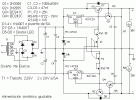In the scheme diagram below we present a 0-30V / 5A adjustable symmetrical power supply that can cover a wide range of applications for laboratory or workshop. Values are included in the design diagram.

The potentiometers P1 and P2 used to adjust each regulator output independently to the desired value in the range of 0 to 30V. C5 and C6 of 47 to 100nF capacitors improve the response regulators against switching transients at the output.
Circuit Contruction:
The assembly is small and compact by using a printed circuit board (PCB). You should pay special attention not to reverse the position of the electrolytic capacitors, also not exchange regulators, in practice it can be seen that the pinouts of the two differ, what should be observed closely because their investment destroyed immediately. The transformer according to the line network and by secondary output 5A.
The contact zone between regulators and the heatsink must be isolated and soak special silicone that help dissipate heat on the radiator, take special care to insulate all terminals thereof and which also would be broken because of a short circuit.
The cables must be of sufficient section 2 or 3 mm diameter, not any resistance and avoid brownouts output loading. To control at all times the value of the output voltage supplied by the source, we recommend incorporating into the box, two indicators one branch, as if two voltmeters and ammeters desired as (or galvanometer).
Power supply is an electronic device that supplies electric energy to an electrical load. The primary function of a power supply is to convert one form of electrical energy to another and, as a result, power supplies are sometimes referred to as electric power converters. Some power supplies are discrete, stand-alone devices, whereas others are built into larger devices along with their loads. Examples of the latter include power supplies found in desktop computers and consumer electronics devices.